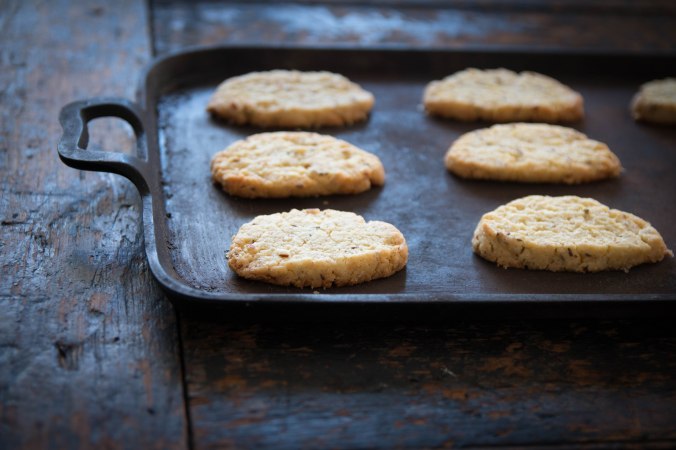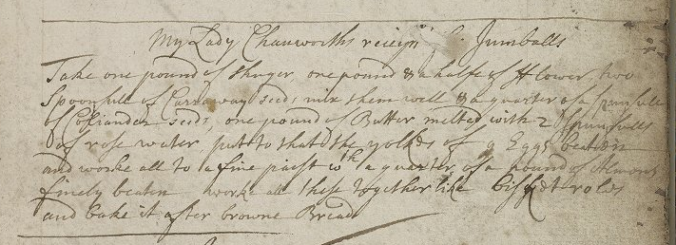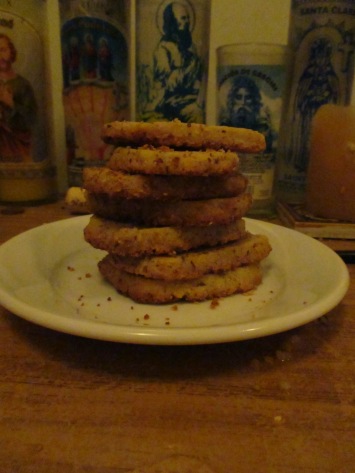
Photo by Carley Storm Photography http://www.carleystormphotography.com
It’s high time that we talk about jumballs. We were initially mystified by the moniker, but jumballs are a classic early modern treat: A rich, satisfying, highly-spiced, shortbread cookie. They are the single most delicious thing we’ve cooked from the archives to date.
Even a quick search to define the term revealed the jumball’s long-term popularity, from Gervase Markam’s classic English Housewife (1649) to the iconic Mrs Beeton’s Book of Household Management (1888), with examples on many other historical cookery sites like this one. The Oxford English Dictionary generalizes among the range of different spices and methods in these various recipes to define early modern jumballs as a “kind of fine sweet cake or biscuit, formerly often made up in the form of rings or rolls.”
In LJS 165 there are two recipes for jumballs back to back: “To Make Jumballs / My Mother Anges receipt” and “My Lady Chanworths receipt for Jumballs.” We thought that the first recipe’s mention of the compiler’s mother (or another source’s mother) was a poignant look into the perennial practice of handing down knowledge from mother to child, most likely mother to daughter. But the final instruction in that first recipe — soaking the baked jumballs in vinegar overnight — was not especially appealing, although it is very likely an excellent method for preserving the biscuits. Besides, who among us can take delicious cookies out of the oven and not eat them immediately? We decided to prepare the second recipe instead: “My Lady Chanworths receipt for Jumballs.” (If any readers try the alternate recipe, we’d love to hear how it turns out.)
The Recipe
My Lady Chanworths receip[t for] Jumballs
Take one pound of shuger, one pound & a halfe of fflower, two
spoonfull of Carraway seeds, mix them well & a quarter of a sponfull
of Coriander seeds one pound of Butter melted with 2 spunfulls
of rose water, put to that the yolkes of 4 Eggs beaten
and worke all to a fine paist with a quarter of a pound of Almons
finely beaten worke all these together like bisket roles
and bake it after browne Bread
Like other sweet and savory recipes from the period, this recipe uses fragrant whole caraway and coriander seeds enlivened by aromatic rose water, the richness of egg yolks and butter, and the deep nuttiness of ground almonds. Other than halving the quantities in the recipe (which still made a lot of cookies) we’ve made no changes to the dough mix and simply reformatted the instructions into a modern style below.
Now, there are a wide variety of ways to shape jumball dough before baking. Recipes call for twisting, rolling, slicing, and folding. Given the texture of the jumball dough in a very hot kitchen (summer in Philadelphia) we decided to follow a classic shortbread method and to roll our dough into a long log, slice cookies 1/4 inch thick, and bake them. (If you try this recipe and shape them differently, send us a photo!)
Our Recipe
*Halved from the original. We also used a baking scale for this one, but we’ve included approximate volume measurements.
1/2 lb sugar (1c)
3/4 lb flour (2 3/4 c)
1 t caraway seeds
1/2 t coriander seeds
1/2 lb butter, melted (2 sticks or 16 T)
1 t rosewater
2 egg yolks, beaten
1/8 lb ground almonds (generous 1/2 c)
Preheat oven to 350F.
Mix flour, sugar, and spices in the bowl of a stand mixer (or a large bowl if mixing by hand). Add melted butter, rosewater, egg yolks, and ground almonds and mix until a uniform dough forms.
Place dough on a lightly floured surface and shape into cookies. We did this by rolling the dough into a log and slicing 1/4 inch cookies, but there are many other ways to shape this kind of dough.
Bake 20 minutes or until brown around the edges. Cool on a rack before devouring, if you have the willpower.
Results
They don’t look like much when you lift them onto the cooling rack (does shortbread ever look impressive?). But the aroma of spice and sweet gives it all away.
Jumballs are truly delicious. Their balance of nut and spice, fragrance and buttery texture is divine. They’d hold their own in a spread of cookies. We’ve since learned that they pair well with Italian Cheese, but we suspected from the beginning that they would complement vanilla ice cream, custard, fresh fruit, or a simple cup of tea.
When we shared these with unsuspecting friends they were bowled-over by the surprising and delightful presence of coriander. And their first guess was that we’d found the recipe on one of the latest trendy food blogs, not through this archival project. We’ll be making these again.










Oh they sound delicious!!! Would you say that the flavour is particularly chrismassy or not really?
The spice flavors really dominate and might come across as a winter or Christmas flavor. I think the Shrewsbury cakes (https://rarecooking.wordpress.com/2014/09/02/shrewsbury-cakes/) we posted a few weeks ago could also be described this way. In my opinion they’re an all-year-round cookie that would also work wonderfully in a Christmas spread (or a Thanksgiving, New Years, or other fall/winter occasion.)
Junbles! haven’t had jumbles for years, only my great aunt made them with fennel or a pinch of allspice not coriander. She didn’t use rosewater but she did use nutmeg. I’d forgotten about them, thank you!
I have no idea whether the change in name is a purely local one, likewise the variations in the spices, but it might just as well be a response to what was available especially during wartime. [like making wartime marzipan with ground semolina and almond essence which is a lot nicer than synthetic marzipan]
That’s really interesting! There are so many variant spellings, methods, and spices around for this one. We definitely saw allspice and nutmeg in some recipes. We also saw notes about modern American “jumbles” including candied citrus.
I have never heard of these before, but I love caraway and coriander. I may have to put them on the roster! I have one question. Did you use salted butter? I would think that using salted butter or adding some salt to the recipe if using unsalted butter would help to bring out the spice flavors. Thanks!
We used unsalted butter. A pinch of salt would be a nice addition!
Reblogged this on DailyHistory.org and commented:
What the heck are Jumballs? Cooking in the Archives has an answer and apparently it is delicious. Jumballs are “a rich, satisfying, highly-spiced, shortbread cookie.” They had me at “cookie.”
In this post they cooked up “My Lade Chansworth” recipe for Jumballs. They point out that these cookies go quite well with their previous recipe Italian Cheese. Good stuff.
Thanks for reblogging!
I’ve made the Shrewsbury Cakes and now these Jumballs for afternoon tea at my 1854 B&B. It took awhile to find Rosewater here in the wilds of Northern California, but got it. They are an interesting and delicious “biskit”. I know the guests are going to love them, thanks for this! Wish I could attach a photo.
Wow! We’re glad to hear that they both turned out well.
We’d love to see a photo, too. If you’re on twitter you can tweet us a photo @rare_cooking and we’ll share it with all our followers on that platform.
Mmmm! I’m making these for Christmas. But since I’m gluten intolerant I’m making them with a rice flour blend. I think they should be good.
I would love these but for the caraway. Being forced to devour certain spices in great quantities as a child has soured me to their charms ever since.
You can keep dill and rosemary, too.
Looks rather delicious!!
Why didn’t you post the whole page of the recipe?
I want to read the vinegar reference.
It looks like the yolk of 9 eggs doesn’t it?
Now im hungry!
Yes they do look good!
Reblogged this on D. J Blackmore and commented:
Food and history therein… what a mouthwatering inspiration. Anticipating licking the crumbs from my lips. Thank you for sharing.
Delicious inspiration: food and history. Would have thought the teaspoon of rosewater would go unnoticed, with the pungent addition of both coriander and caraway, but when all’s said and done, the proof is in the pudding… Guess I’ll just have to try them 🙂
Reblogged this on William Grit and commented:
Chants: cookies, cookies cookies, cookies! Cookies!! COOOOKIEES
How amazing is that? I love cookie recipes but have never seen one containing coriander and caraway seeds. The appearance reminds me of a typical shortbread cookie recipe but I bet the spice gives it a little extra personality. I might try making these closer to the holidays. Thanks for passing it on! 🙂
I’m trying to follow the Paleo diet so these are out….but they look so good! Hmmmm….maybe I can find a way to convert…. I love the idea of the coriander and caraway.
How do I get rose water?
Reblogged this on expressionsartlessons and commented:
This is awesome! I cant wait to try!
Wow! Thanks for the translation too…I didn’t know that the old word for recipe was reciept….the German word is “rezept”
Reblogged this on Wunderwaldverlag and commented:
Bestens geeignet für Recherchen – so hat man früher gekocht
Absolutely fascinating! What a clever recipe! Can’t wait to try it.
Such a great idea for a blog. Super clever. Just stumbled across this and love every bit of it. Well done:)
Reblogged this on Joyful Domesticity.
Yummmmm! I love cooking historical food. Question: where the heck does one get rosewater??
I have it in mind to make blancmange. It’s mentioned in the Louise May Alcott book “Little Women” and I’ve always wanted to try it.
Reblogged this on Apps Lotus's Blog.
this is awesome!
I am so glad I found this site. I have a colonial fruit cake I make from a recipe I found in Colonial Williamsburg in Virginia. Old, historic recipes can have some of the best flavours .
Pingback: “My Lady Chanworths receipt for Jumballs” | C.M. Stone
What a wonderful unique blog. You had me at Jumballs LOL! I’m looking forward to exploring more.
This is really interesting. I think I might have to try these 🙂
Yum! They look amazing!
Wow! This looks yummy. Something new for me to try out and experiement my tsste buds. Thank you for sharing. Looking forward to some more receipes.
Please visit me too at http://www.twentyfirstcenturymomma.wordpress.com
I made some jumballs and “desart cakes” today. The desart cakes came out okay, but the jumballs are delicious!
I opted to interpret “spoonful” in the original recipe as a tablespoon, rather than a teaspoon based on a few other recipes from the same period that I’ve made recently. However, I haven’t researched the issue in any detail and my interpretation could be off.
I made a half portion and this still made plenty of cookies! Here’s what I ended up using:
227g sugar
341g flour
1 Tbsp. caraway seeds
1/2 tsp. coriander seeds*
1 c. butter, melted
1 Tbsp. rosewater
2 large egg yolks
57g blanched almonds, ground
*I went with 1/2 tsp. for the coriander seeds just to make my life a bit easier. I interpreted the “quarter of a sponfull” in the original recipe as 1/4 Tbsp. or 3/4 tsp. I figured 3/8 tsp. was close enough to 1/2 tsp. that it wouldn’t make a huge difference to the recipe and just went with that because it was easier.
I love how these turned out and will definitely be making them again! I may also look up other recipes and try a few different versions just to compare and contrast.
Oh, and for those looking for rosewater: if you have any ethnic grocery stores or markets near you, try those. I live near an Indian grocery store as well as a halal/middle eastern grocery store, both of which carry rosewater. I’ve also had good luck finding ingredients like that at Food Basics, if you have one of those near you.
Thanks for sharing not only your experience with the recipe, but also for including your revised proportions and ingredients!
As a Penn graduate myself, I was especially pleased when a friend sent me the link to your blog. I’ve been sharing it with other Penn friends.
I made these delicious cookies yesterday, with a few additions to the instructions. I crushed the seeds in a little mortar and pestle (and I might try toasting them next time, for there will certainly be a next time!).
When I’d mixed the dough, I put the bowl in the refrigerator for maybe ten minutes — which made the dough a little easier to work with. I made four rolls, wrapping each in cling wrap and putting it into the fridge. I took them out one by one to slice them, noticing that the last one (longest chilling time) was both easiest to slice and had the best texture after baking. This step would, of course, not been available to the original baker, except in winter.
I also used salted butter, because I like the taste, and I’d do that next time too.
I knew I’d seen cookies called “jumbles” before, so I looked in my mother’s 1948 Betty Crocker collection of cooky recipes. They give a recipe for jumbles as a “key” recipe for a drop cooky (not a shortbread) with lots of variations, one of which is the classic Toll House cooky.
Next up to try: carrot pudding!
Thanks so much for this very well-done blog. I look forward to new posts.
Dovie
Hello. I’d been interested in jumballs for quite some time when I came across this fascinating blog. Your jumballs are excellent and rather different because of the caraway seeds; most other historic recipes use aniseed and coriander. As for the shapes, the recipe contains too much butter for anything else. I’m afraid Lady Chanworth’s dough could never be twisted, rolled or folded unless perhaps it was chilled for some time. In order to make a stiffer paste, I would try a recipe which lets the cook decide on the amount of flour needed. You may find one such here: http://www.godecookery.com/engrec/engrec50.html I forward to your next culinary adventure
Pingback: To make Little Cakes, Cooking in the Scripps Archives Part 1 | Cooking in the Archives
Pingback: Solid Sillibubs | Cooking in the Archives
Pingback: Cooking Almond Jumballs at the Folger Shakespeare Library | Cooking in the Archives
Pingback: Jumballs from “Mariabella Charles her booke” Clark Library MS.1950.009 | Cooking in the Archives
Pingback: Marmalaid of Apricocks, a case study in Heat | Cooking in the Archives
Pingback: To Make Quince Cream | Cooking in the Archives
Pingback: Your Kitchen is a Time Machine: An interview with Marissa Nicosia of Cooking in the Archives – ars longa
Pingback: Christian Barclay’s Almond Jumballs | Cooking in the Archives